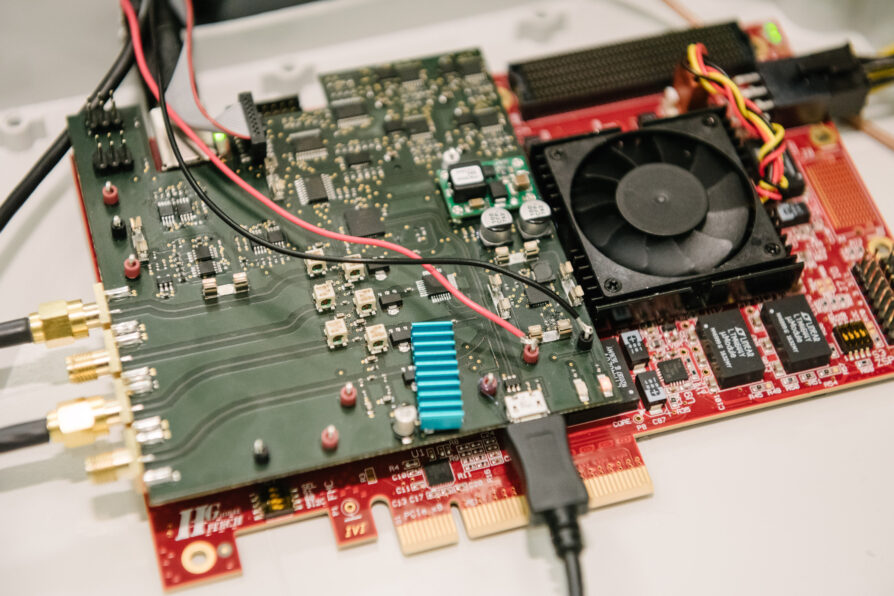The National Cyber Security Centre (NCSC) has published a new white paper on quantum security technologies, which discusses both quantum key distribution (QKD) and quantum random number generators (QRNGs).
The paper acknowledges that QKD mitigates against security issues of traditional public key cryptography by utilising fundamental quantum mechanics, as opposed to hardness of mathematical problems. The latter could be vulnerable to attacks by future large-scale quantum computers for example through Shor’s algorithm. The paper recognises that QKD enables two parties to be able to share a secret key, where the key cannot be observed by an eavesdropper without the parties being aware. However, it also highlights that QKD does not provide initial authentication, meaning it could be vulnerable to physical man-in-the-middle attacks. The paper recommends that QKD should be deployed in conjunction with routine cryptographic mechanisms, which ensure authentication, and that further research is required to understand how QKD can be integrated into systems of classical components. It concludes that: “NCSC does not endorse the use of QKD for any government or military applications, and cautions against sole reliance on QKD for business-critical networks, especially in Critical National Infrastructure sectors.” (sic)
With regard to QRNGs, the paper recognises that these are able to produce random numbers at very high speeds and in their ideal state, can produce truly unpredictable numbers. However, it comments that this unpredictability is hard to realise due to noise from the classical circuitry required and the use of classical circuitry can leave the QRNGs open to implementation level attacks, similar to those experienced by classical RNGs. It is noted that the NCSC will continue to support research surrounding QRNGs.
In the Quantum Communications Hub we are pleased to see that NCSC continues to engage in the important sector of quantum security technologies, and have revised their previous position with respect to the use of QKD in business-critical networks. However, it is also important to highlight the progress that has been made with quantum security technology research and development over the past few years and the planned work going forward in the UK National Quantum Technologies Programme.
Clearly, one of the main concerns remaining with regards to QKD is authentication. The limitations of QKD in general and the issue of authentication, in particular, have long been identified by the community and highlighted as such in specialist publications. Indeed, a combination of both quantum-based and post-quantum infrastructure solutions has been long advocated as the most effective against the threats posed by the advance of quantum computing, both in technical references and trade and public engagement press. Examples of such, co-authored by Hub investigators/partners, include:
- the European Telecommunications Standards Institute’s white paper ‘Implementation Security of Quantum Cryptography’
- an article written by Hub Director, Prof Tim Spiller, and Dr Christoper Chunnilall from the National Physical Laboratory, for Laser World Focus, ‘Quantum Photonics: Ensuring quantum-secured communications’
- an article written by Hub Director, Prof Tim Spiller, for the IMPACT publication ‘Making tomorrow’s world secure today’
- and an article written by Hub Director, Prof Tim Spiller, for the Royal Signals Journal, ‘Quantum Communications Technologies’.
Hybrid solutions of quantum-based and post-quantum technologies are a key aspect of the work which will be undertaken by the Hub in the second phase of the National Programme.
In response to the white paper, Hub Director, Professor Tim Spiller made the following statement:
“Whilst I welcome the shift in NCSC’s position with respect to the use of QKD in business-critical networks, I think it is also important to highlight the progress that has been made with quantum security technology R&D over the past few years.
With respect to QKD, the requirement for authentication is well-appreciated. A very appealing solution will be to use quantum-safe asymmetric (public key) algorithms to authenticate QKD between transmitters (Alices) and receivers (Bobs) that have never met before. Even in a dynamic and evolving network scenario, this can provide long term quantum-safe keys through QKD, underpinned by an authentication algorithm that is only required to be quantum-safe at the specific time of use. The Quantum Communications Hub and other projects in the UK National Quantum Technologies Programme are already working on these hybrid solutions, and the standards to underpin them.
With respect to QRNGs, their significant appeal is the true unpredictability of their randomness. For this, it is clearly crucial to assure the “quantumness” of the source of entropy that underpins the randomness. Over the last few years the Quantum Communications Hub has been establishing the principles and processes for assuring the quantumness underpinning current QRNGs working closely with the UK’s national metrology institution, the National Physical Laboratory, and in collaboration with industrial partners. We will be continuing this multi-disciplinary strand of work over the next five years (phase 2) of the Hub, alongside our drive towards future device-independent assurance. Such new QRNGs, alongside other quantum security technologies based on entanglement, will offer an even broader spectrum of assured security solutions in the future.”
Hub investigators are keen to work together with NCSC (as per the recommendations of the UK Government Blackett review) and our many industry partners to run a number of field trials across the UK’s Quantum Network, seeking to establish the most quantum secure solutions for our national infrastructure both in ICT and other sectors.
*With credit to D. Tsantilis/EPSRC for the photograph.




